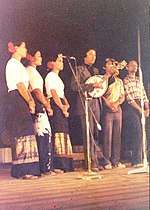U Pannya Jota Mahathera
Ven. U Pannya Jota Mahathera (Burmese: ဦးပညာဇောတမဟာထေရ်, Bengali: উ পঞ্ঞা জোত মহাথের), locally known as Guru Bhante (December 22, 1955 – April 13, 2020) was a Bangladeshi Theravada monk. He was born in the Royal Bohmong family[1] at Bandarban, East Pakistan. He previously served the government of Bangladesh as a judge and magistrate for about eight years; then he became a Buddhist monk.
U Pannya Jota Mahathera | |
|---|---|
ဦးပညာဇောတမဟာထေရ်
| |
 Ven. U Pannya Jota Mahathera in 2015 | |
| Other names | Guru Bhante |
| Personal | |
| Born | U Saw Hla December 22, 1955 |
| Died | April 13, 2020 (aged 64) |
| Religion | Buddhism |
| Nationality | Bangladeshi |
| Parents |
|
| Ethnicity | Marma |
| Sect | Theravada Buddhism |
| Education | L.L.B, L.L.M, B.C.S |
| Known for | Founder of Buddha Dhatu Jadi, Rama Zadi, The World Buddha Sasana Sevaka Sangha, etc. |
| Other names | Guru Bhante |
| Occupation | Ex. SR. ASSTT. JUDGE |
| Senior posting | |
| Based in | Pannya Passanara Buddhist Monaster, Ujani Para, Bandarban, Bangladesh |
| Awards | (Five Hundred) Leaders of Influences, ABI, USA, (1997) Saddhamma Jotika Dhaja, Myanmar, (2002) |
Biography
Early life
U Pannya Jota (Birth name: U Saw Hla, Bengali: উচহ্লা) was born in Bandarban, East Pakistan, on December 22, 1955. His father Hla Thowai Phru, his mother Aung Mri Ching, and his grandfather Kyaw Zaw Than was the late King of Royal Bohmong family. At the early of six or seven, he began to attend school in Bandarban and after his high school/college he was admitted to Dhaka University in the Law department.
_as_an_Assistant_Judge_and_Magistrate_of_Government_of_the_People%E2%80%99s_Republic_of_Bangladesh.jpg)
During his university life, he has led several organizations in promoting education among the students. He has joined many organizations and worked for the promotion of indigenous cultural heritage. He used to sing traditional songs at functions and many popular Marma songs like “Sangrai ma” [2] were composed by him. He also formed a music band named The Royal Artists Group (Bengali: দি রয়েল শিল্পীগোষ্ঠী). After his graduation, he served Bangladesh Government as a Judge and Magistrate for about 8 years. As a Judge, he has worked for the justice and peace of the society. At the second time of ordination he took with him a strong determination to become Buddhist monk forever. He resigned from the job and became a Buddhist monk in 1990 at Ching Mrong Bihara.[3] From that day he became known as U Pannya Jota Mahathera. Since then, he has been working tirelessly for Buddha sasana.
Life as U Pannya Jota
U Pannya Jota was very keen in learning and practicing Buddhism in depth. He believed Buddhism has the potential to bring peace in the minds of the people. The teaching and meditation in Buddhism were his strengths for his serving society for peace building. He visited various places and taught dharma to the laypeople. He was one of the social reformers who came up with scientific understanding of Buddhism and denied the superstitious beliefs that many people in Bangladesh used to believe due to their inaccessibility to teachings of the Buddha. Besides his preaching, he most of the time spent practicing meditation. He has visited various countries and met many world popular meditation teachers like S.N. Goenka. He learned meditation from many great meditation masters from India and Burma.
Publications
He was not only practitioner but also a Buddhist scholar. He practiced what he said. And he said what he practiced. That's why he has taken tasks of publishing books on the topics of Buddhism. And these books are widely read by Bangladesh Buddhist readers.
| Name of Books | Series | Years | Version |
|---|---|---|---|
| Sadhana Paddhati O Dikkha | 1990 | Bangla | |
| Bidorshon Darpon | Vipassana Mirror | Bangla | |
| Poncha Guno Ananta Bandana | 2003 | Bangla, Marma | |
| Deshona Kolpotoru | Part-1 (Nirvana for Them) | 2005 | Bangla |
| Deshona Kolpotoru | Part-2 (Is Buddhism a religion?) | 2005 | Bangla |
| Deshona Kolpotoru | Part-3 (Reincarnation and Science) | 2005 | Bangla |
| Deshona Kolpotoru | Part-4 (Nation, Dhamma, Buddha Sasana) | 2015 | Bangla |
| Deshona Kolpotoru | Part-5 (Four Saint Dhamma) | 2018 | Bangla |
Establishment
Additionally he also built several temples in the country and outside the country. The objective of building temples in other countries is to keep the exchange of ideas and ties strong between countries. These are some of his temples built by him and some are under construction.
- Zin Mara Jayi Dhatu Zadi | Bandarban, Bangladesh. (Reconstruction, more than 250 years old)
- Khyaungwa Kyaung Raja Vihara (Chief priest) | Bandarban, Bangladesh.
- Pannya Passanara Buddhist Monastery | Bandarban, Bangladesh.
- Buddha Dhatu Naundawgree Zadi | Bandarban, Bangladesh.
- Maha Shuka Chutongbrae Buddha Dhatu Jadi | Bandarban, Bangladesh.
- Rama Naundawgree Pagoda | Bandarban, Bangladesh.
- Rama Zadi | Bandarban, Bangladesh.
- Bangladesh Buddhist Monastery | Yangoon, Myanmar.
- Bangladesh Buddhist Monastery | Maung Daw, Arakan State, Myanmar.
- Kyaukmalaung Zadi | Bandarban, Bangladesh. (under construction)
- The Holy Jaghat Santi Sukha Zadi | Chimbuk, Bandarban, Bangladesh. (under construction)
- Buddha Gaya Temple | Buddha Gaya , India.(under construction)
Buddha Dhatu Jadi

One of the most famous temples is the Buddha Dhatu Jadi. It is an amazingly decorative temple on the hill top. The Golden Temple with golden bell set on a dragon statue along with the second biggest Buddhist statue of Bangladesh. The local people called the Golden Temple as ‘Kyang’. The Buddha's dhatu (relic), which is enshrined in the temple, was a gift given to Ven. U Pannya Jota Mahathera in 1994 by the State Sangha Maha Nayaka Committee of Myanmar. The Dhatu of Golden Temple has been believed to provide peace and contentment for mankind.
Rama Zadi
Rama Zadi is the largest and tallest Buddhist temple of Bangladesh, which is located in Hoda Babur Ghona area of Rohangchhari Upazila Road, 3 km away from the Bandarban district town. Its height is almost 175 ft.
Participation
These are some of international conferences he attended in promoting world peace by exchange of ideas and also to keep connection with the Buddhist countries around the world.
Social welfare

Some of his organizations are for the social welfare purpose. He built schools and learning centers especially for children and monks. His aim is to educate the young generation of the society because he believed the future lies in the hands of the youth. The cause of tyranny and conflicts in the society is due to education. People with improper education and no education could create problems in the society. They could do foolish things because of lack of literacy and education. Many social conflicts are done by illiterate people since they can't read and think about the issue. So the most venerable U Pannya Jota's aim is to build an educated society by providing secular and religious studies.
He also hoped that children in his institutions will be examples and contributors to the society. In the documentary film he was interviewed about his works for the children and he said that he wanted to provide education for poor children whose parents are not able to pay education fees to send their children to schools, and he mentioned some of these children are far from remote and hill areas of Chittagong Hill Tracts where there is not access to modern schools and facilities. These are some of his social institutions for children.
- Sasana Vaddhana Pariyatti Kyaung (Religious school)
- Be Happy Learning Centre (Orphanage & Free school)
- Kyaukmalaung Girl Hostel (Orphanage & Free school) (under construction)
The World Buddha Sasana Sevaka Sangha
Notes
References
- The Royal Family. "Bohmong Kingdom".
- "Story Behind Sangrai Ma". Documentary by Khola Chokh.
- "Ching Mrong Bihara". rangamati.gov.bd.
- "World Buddhist Summit in Myanmar". Retrieved 9 December 2004.
- World Buddhist Summit (4th : 2004 : Yangon, Burma). Myanmar: World Buddhist Summit. 9 December 2004.
- "United Nations Day of Vesak 2008".
- "Religious Conference for World Peace". Retrieved 16 May 2015.
- "World Religions Conference, Seoul, 2015".
External links
- U Pannya Jota Mahathera on Facebook
- Check in at Buddha Dhatu Jadi and Rama Zadi on Facebook
- Dhamma Speech by U Pannya Jota Mahathera on YouTube
| Part of a series on |
| Theravāda Buddhism |
|---|
 |
|
|
Doctrine
|
|
Key Figures |
_in_eye-catching_heroic_pose.jpg)
